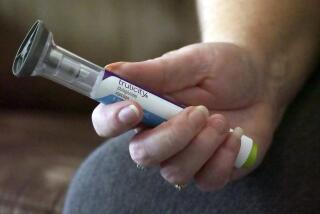Diabetes: A Crash Course in Medicine
- Share via
November is National Diabetes Month. Today, two views: from a teenage diabetic and a pediatric endocrinologist who cares for children and adolescents with diabetes.
*
I have spent the last 22 years caring for children and adolescents with diabetes, and I continue to be amazed, awed and impressed by my patients and their families.
Diabetes is a terrible disease, a chronic metabolic disorder for which there is no cure. The vast majority of people have the false perception that diabetes is not serious and that insulin injections (or, for some people with type 2 diabetes, oral medication) are as good as a cure.
Not true. Inadequately controlled diabetes leads to blindness, kidney failure, heart disease, stroke, nerve damage and limb amputations. However, the future of those with diabetes is not all bleak.
Results of a 10-year study reported in 1993 proved that if the blood sugars were kept near the normal range, the risk of developing the complications listed above were decreased by as much as 60% to 70%. Well, this sounds great, but it isn’t easy and it is not fun. It is hard work, and the work never ends.
*
A day in the life of a child or adolescent with diabetes starts soon after waking, when he or she takes the first of four to eight (or more) blood tests of the day. Using a device that has a spring-loaded blade, he or she obtains a drop of blood, which is placed on a small, specially designed strip, which, when put into a glucose meter, indicates the level of glucose in the blood at that time.
The child with diabetes--or a parent or other responsible adult--then carefully measures the amount of insulin (the hormone that controls the flow of glucose into the body’s cells) into a syringe and injects the insulin into the tissues under the skin.
One would think that this would be enough of a hardship for anyone, but it is just the beginning for a child, adolescent or adult with insulin-dependent diabetes.
After taking the insulin injection, most children will wait 15 to 60 minutes for the insulin to start working before they can eat breakfast. If their blood glucose was higher than the “normal” level, then they need to determine how much extra insulin they need and how much longer they need to wait to eat--while the rest of their family or friends just eat.
While at school, they need to worry about when during the day PE will be scheduled and how much activity they will have, as greater activity causes a more rapid and prolonged lowering of the level of blood glucose, which can lead to the annoying and often dangerous effects of hypoglycemia (low blood sugar).
Often, extra food needs to be eaten prior to increased activity to prevent low blood sugars even if the person is not hungry.
*
The child with diabetes and his or her parents must constantly survey their lives to search for events that may have an effect on diabetes--and there are many.
Once home from afternoon activities, youths need to decide whether the activity they just had will make them need to adjust their food for their usual insulin injection given at dinner time. Obviously, any activity after dinner can affect the amount of insulin required. If they want more food, they will need to take more insulin.
Now comes the often worst time of the day for parents of a child with diabetes: bedtime. How much insulin will be needed to control the diabetes and yet take into consideration activity level or potential changes in food? Does the child need extra food to prevent the frightening and often devastating complication of hypoglycemia, or extra insulin because the blood glucose level was too high?
Is the child at risk of developing low blood glucose and possibly seizures during the evening? Should he or she eat more, or take less insulin? Should he or she wake up in the middle of the night to check the blood sugar level?
And then: How does the child deal with parties and dances, and trips away from home? Who should he or she tell about the diabetes, and how much should they learn to help the child if needed?
*
So much to do and so much to learn! When you have diabetes, you become your own “doctor,” in a sense, working with your doctor and diabetes team to control your diabetes.
What I have learned from my patients, and what is so awesome, is how well these children and their families do with all of these tasks. How well with the appropriate support they adapt these new requirements into their lives without giving up their lives. How much even young children know about their diabetes and how they teach and support others. How they do all of the things they need to do and get up and do it all the next day.
Diabetes is not fun, but new insulins, glucose meters and insulin pumps now allow for easier care and increased freedom for people with diabetes.
The future is much brighter now that we know we can reduce complications, but it is not enough. It still takes too much work. We need a cure for diabetes, and that takes money for more research. Increased dollars were set aside this year by Congress and President Clinton, but it is not enough. We all need to do more.
*
Fisher is president of the American Diabetes Assn., Western Region, and director of the Department of Endocrinology and the Diabetes Division of Pediatrics at the City of Hope National Medical Center in Duarte.






